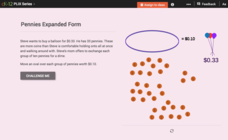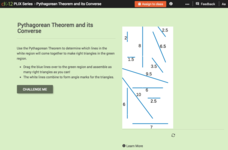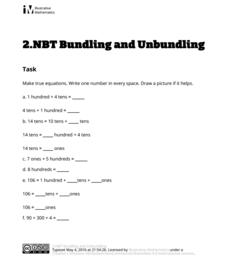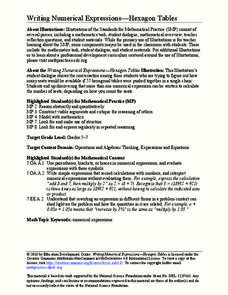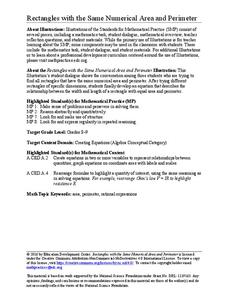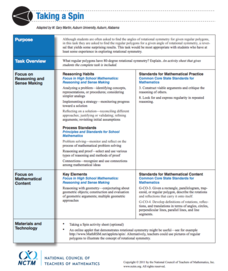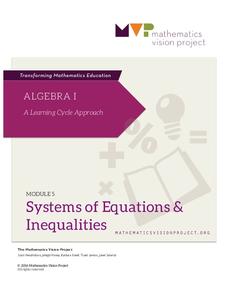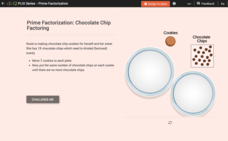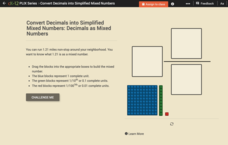CK-12 Foundation
Numbers in Expanded Form: Pennies Expanded Form
Beginning with a word problem that poses the question of making groups of 10 pennies to translate into a single dime, pupils are challenged to make sense of the amount of dollars 33 cents is in expanded form.
CK-12 Foundation
Equivalent Fractions: Number Line
Arrange improper fractions on a number line to determine the equivalency to whole numbers. The number line starts at -4 and ends at 4, while users must turn the improper fraction into a proper fraction in order to place it on the number...
CK-12 Foundation
Fraction and Mixed Number Comparison: Pumpkin Pie
Compare fraction models to fractions on a number line in an interactive that uses pumpkin pies as the model. Pupils look at pumpkin pie models to determine their improper fraction value. They use their knowledge to answer five questions...
CK-12 Foundation
Pythagorean Theorem and Its Converse
To be a right triangle, or not to be — that is the question. Scholars drag line segments in an Internet application to see if they form right triangles. Once they get the results of the activity, they connect them to the converse of the...
CK-12 Foundation
Percent of a Number: Rock Climbing
What percent of the 100 ft. rock has Marta climbed? Young mathematicians find the percent of number (the rock height) by moving the climber up and down the rock.
Illustrative Mathematics
Find the Missing Number
First graders are asked to find the missing numbers in subtraction and addition equations. Each missing number is represented with a box and appears as an addend, subtrahend, sum, or difference.
Illustrative Mathematics
Maria’s Marbles
Ali has more marbles than Maria in some of these word problems, while in others Maria has more marbles than Ali. First graders are tasked to read each word problem and solve how many marbles each girl has.
CK-12 Foundation
Addition of Polynomials: Splitting into Tiles
Count on tiles to add polynomials. Pupils drag virtual algebra tiles onto colored mats to represent the sum of two polynomials. The learners count the number of like tiles to find the coefficient of each term. They finish...
Illustrative Mathematics
Bundling and Unbundling
Seven tens, plus five ones, equals 75. Five ones, plus seven tens, also equals 75. These are the types of equations learners are asked to make true in a worksheet with 11 unfinished equations.
CK-12 Foundation
Sample Spaces and Events: Triple Spin!
Scholars determine the number of possible outcomes when a spinner is spun three times. They start with the case of one spin and build up to the case of three spins.
CK-12 Foundation
Fundamental Counting Principle with and without Repetition: Outfit Combinations
But I have nothing to wear! Using an interactive, individuals create all possible outfits from three shirts, one belt, and two pairs of pants. Answering a set of challenge questions helps them see what they have learned from the...
Education Development Center
Writing Numerical Expressions—Hexagon Tables
Explore a basic pattern to practice writing expressions. In collaborative groups, learners examine a contextual pattern and write an expression to model it. The task encourages groups to describe the pattern in multiple ways.
Illustrative Mathematics
Red and Blue Tiles
Here, second graders are tasked to find the patterns that have an even number of tiles. They are asked to think about why these patterns are even or odd and explain how they know.
CK-12 Foundation
Permutations and Combinations Compared: Colored Candies
Here's a sweet resource on sample spaces. An enticing interactive allows users to list all possibilities for the flavors of candy given to a friend. Scholars must also determine whether permutations or combinations are more...
Education Development Center
Rectangles with the Same Numerical Area and Perimeter
Is it possible for a rectangle to have the same area and perimeter? If you disregard units, it happens! In a challenging task, groups work to determine the rectangles that meet these criterion. The hope is that learners will naturally...
Education Development Center
Similar Triangles
Model geometric concepts through a hands-on approach. Learners apply similar triangle relationships to solve for an unknown side length. Before they find the solution, they describe the transformation to help identify corresponding sides.
Illustrative Mathematics
Making 124
How many ways can you make the number 124 using only tens and ones? Use a task that prompts young mathematicians to make 124 in as many ways as possible.
CK-12 Foundation
Input-Output Tables for Function Rules
How does changing a graph affect the function? Learners watch the changing input-output table as they adjust the location of the line graph. Questions prompt them to complete a table of values and determine the function rule.
CK-12 Foundation
Limit of a Sequence: Finding the Limit of a Sequence (Part 3)
Limit the view of sequences on both sides of the axis. Learners explore an alternating sign sequence. Using a graphical display of the first 10 terms of the sequence, pupils determine the formula for the general term. they then use the...
National Council of Teachers of Mathematics
Taking a Spin
It does not divide into 360 evenly, so it cannot work. The resource extends pupils' thinking about rotational symmetry. By asking for a figure with a rotational symmetry of a seemingly impossible angle, the activity requires learners to...
Mathematics Vision Project
Module 5: Systems of Equations and Inequalities
Systems of equations and inequalities model contextual situations. A set of 12 lessons build a solid understanding of writing and solving systems of equations and inequalities using a variety of methods. The module is the fifth in a...
Concord Consortium
Bricks for Books
Maximize a profit with an understanding of geometric dimension. A real-world task challenges learners to design a pattern using three different brick shapes. The bricks are dedicated with a different donation for each shape, so part of...
CK-12 Foundation
Prime Factorization: Chocolate Chip Factoring
An interactive resource challenges mathematicians to show what they know about prime factorization. Five multiple-choice, true or false, and discussion questions use chocolate chip cookies to set a real-world application of the...
CK-12 Foundation
Decimals as Mixed Numbers
Five questions—multiple-choice, true or false, and a discussion—make up an interactive that focuses on decimals as mixed numbers. Moveable blocks assist scholars in finding solutions.
Other popular searches
- Manipulatives Math Lessons
- Math Manipulatives Algebra
- Math Manipulatives Slope
- Math Manipulatives Multiply
- Manipulative's Math Lessons
- Math Manipulatives Division
- Math Manipulatives Coins
- Math Manipulatives Sets
- Math Manipulatives Grade 5
- Ab Patterns Math Manipulatives
- Using Math Manipulatives
- Math Manipulatives Geade 5
